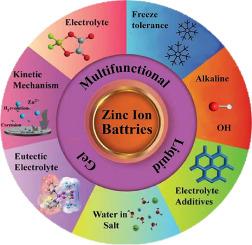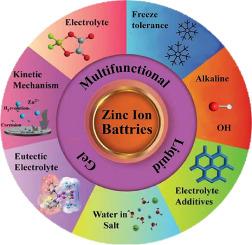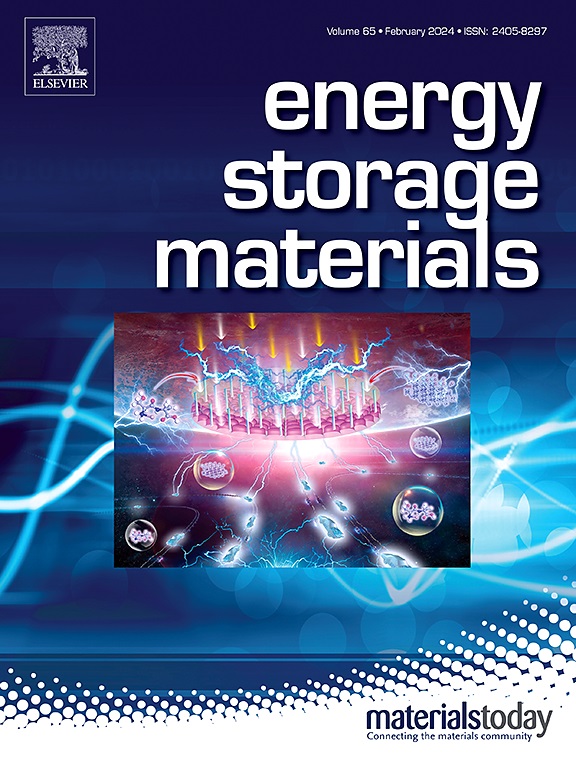Unlocking the potential: Innovations and strategies for electrolyte optimization in Zn-ion batteries
IF 18.9
1区 材料科学
Q1 CHEMISTRY, PHYSICAL
引用次数: 0
Abstract
Zn-ion batteries have emerged as promising energy storage devices due to their high energy density, low cost, and environmental friendliness. To fully exploit their potential, it is essential to enhance their performance through innovative strategies for electrolyte optimization. This article presents a comprehensive review of recent advancements and approaches aimed at improving the performance of Zn-ion batteries by optimizing the electrolyte. The review discusses the importance of electrolyte composition and its impact on ionic conductivity, stability, and safety. It explores various electrolyte components, such as solvents, salts, and additives, and highlights their influence on ion transport and the prevention of side reactions. Additionally, the challenges posed by the aqueous electrolyte system are addressed, with corresponding countermeasures suggested. Strategies for achieving high ionic conductivity and stability are discussed, including the use of novel solvents, salt combinations, and additives with improved properties. Furthermore, this article underscores the significance of advanced characterization and modeling in understanding electrolyte-electrode interactions and guiding electrolyte optimization efforts. In conclusion, emerging trends and future directions in electrolyte optimization for Zn-ion batteries are outlined, providing a roadmap for future research and development in this field.


释放潜能:锌离子电池电解质优化的创新与战略
由于能量密度高、成本低、环境友好,锰离子电池已成为一种前景广阔的储能设备。为了充分挖掘其潜力,必须通过创新的电解质优化策略来提高其性能。本文全面综述了旨在通过优化电解质提高锌离子电池性能的最新进展和方法。综述讨论了电解质成分的重要性及其对离子导电性、稳定性和安全性的影响。它探讨了各种电解质成分,如溶剂、盐和添加剂,并强调了它们对离子传输和防止副反应的影响。此外,还探讨了水性电解质系统带来的挑战,并提出了相应的对策。文章还讨论了实现高离子传导性和稳定性的策略,包括使用新型溶剂、盐组合和性能更好的添加剂。此外,本文还强调了先进的表征和建模在理解电解质-电极相互作用和指导电解质优化工作方面的重要意义。最后,文章概述了 Zn 离子电池电解质优化的新趋势和未来方向,为该领域的未来研究和开发提供了路线图。
本文章由计算机程序翻译,如有差异,请以英文原文为准。
求助全文
约1分钟内获得全文
求助全文
来源期刊

Energy Storage Materials
Materials Science-General Materials Science
CiteScore
33.00
自引率
5.90%
发文量
652
审稿时长
27 days
期刊介绍:
Energy Storage Materials is a global interdisciplinary journal dedicated to sharing scientific and technological advancements in materials and devices for advanced energy storage and related energy conversion, such as in metal-O2 batteries. The journal features comprehensive research articles, including full papers and short communications, as well as authoritative feature articles and reviews by leading experts in the field.
Energy Storage Materials covers a wide range of topics, including the synthesis, fabrication, structure, properties, performance, and technological applications of energy storage materials. Additionally, the journal explores strategies, policies, and developments in the field of energy storage materials and devices for sustainable energy.
Published papers are selected based on their scientific and technological significance, their ability to provide valuable new knowledge, and their relevance to the international research community.
 求助内容:
求助内容: 应助结果提醒方式:
应助结果提醒方式:


